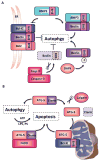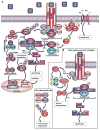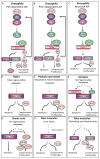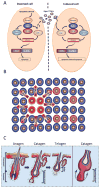Live to die another way: modes of programmed cell death and the signals emanating from dying cells
- PMID: 25991373
- PMCID: PMC4511109
- DOI: 10.1038/nrm3999
Live to die another way: modes of programmed cell death and the signals emanating from dying cells
Abstract
All life ends in death, but perhaps one of life's grander ironies is that it also depends on death. Cell-intrinsic suicide pathways, termed programmed cell death (PCD), are crucial for animal development, tissue homeostasis and pathogenesis. Originally, PCD was almost synonymous with apoptosis; recently, however, alternative mechanisms of PCD have been reported. Here, we provide an overview of several distinct PCD mechanisms, namely apoptosis, autophagy and necroptosis. In addition, we discuss the complex signals that emanate from dying cells, which can either trigger regeneration or instruct additional killing. Further advances in understanding the physiological roles of the various mechanisms of cell death and their associated signals will be important to selectively manipulate PCD for therapeutic purposes.
Conflict of interest statement
The authors declare no competing interests.
Figures





References
-
- Vogt C. Untersuchungen über die Entwicklungsgeschichte der Geburtshelferkröte (Alytes obstetricans) Solothurn: Jent und Gassman. 1842:130.
-
- Lockshin RA, Williams CM. Programmed cell death. II Endocrine potentiation of the breakdown of the intersegmental muscles of silkmoths. J Insect Physiol Dev. 1964;10:643–64.
-
- Tata JR. Requirement for RNA and protein synthesis for induced regression of the tadpole tail in organ culture. Dev Biol. 1966;13:77–94. - PubMed
-
- Ellis HM, Horvitz HR. Genetic control of programmed cell death in the nematode C. elegans. Cell. 1986;44:817–29. - PubMed
Publication types
MeSH terms
Grants and funding
LinkOut - more resources
Full Text Sources
Other Literature Sources

